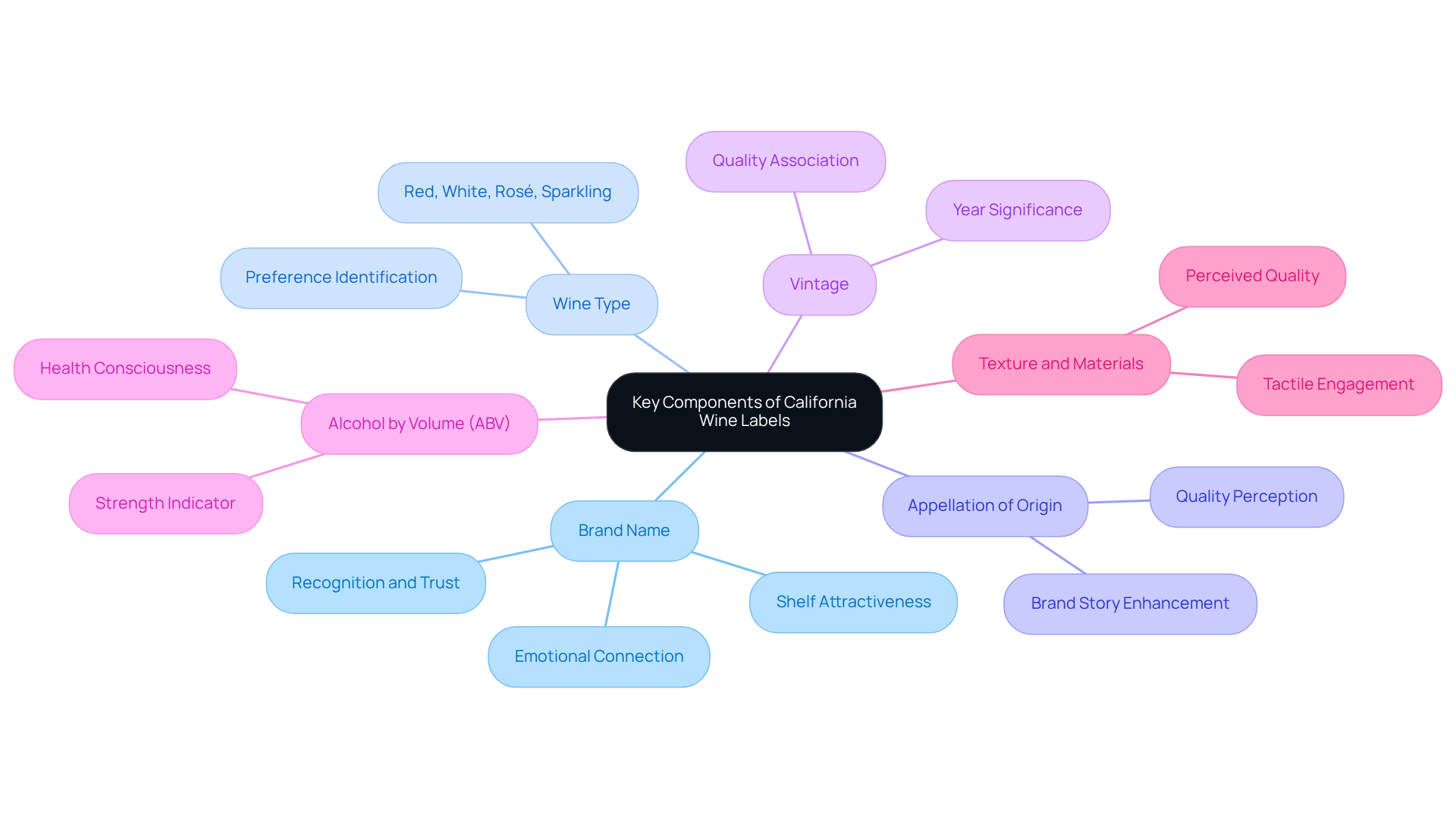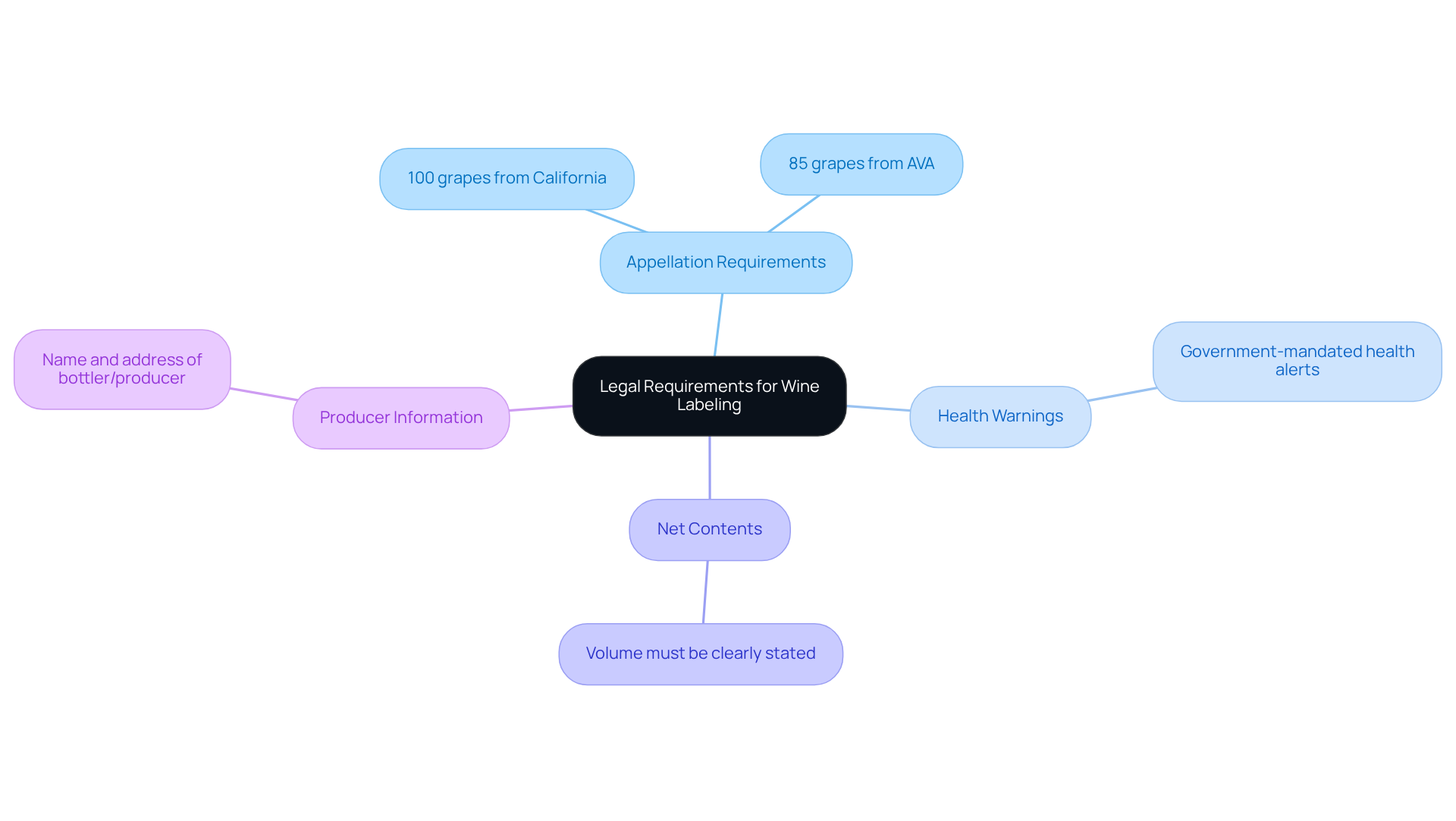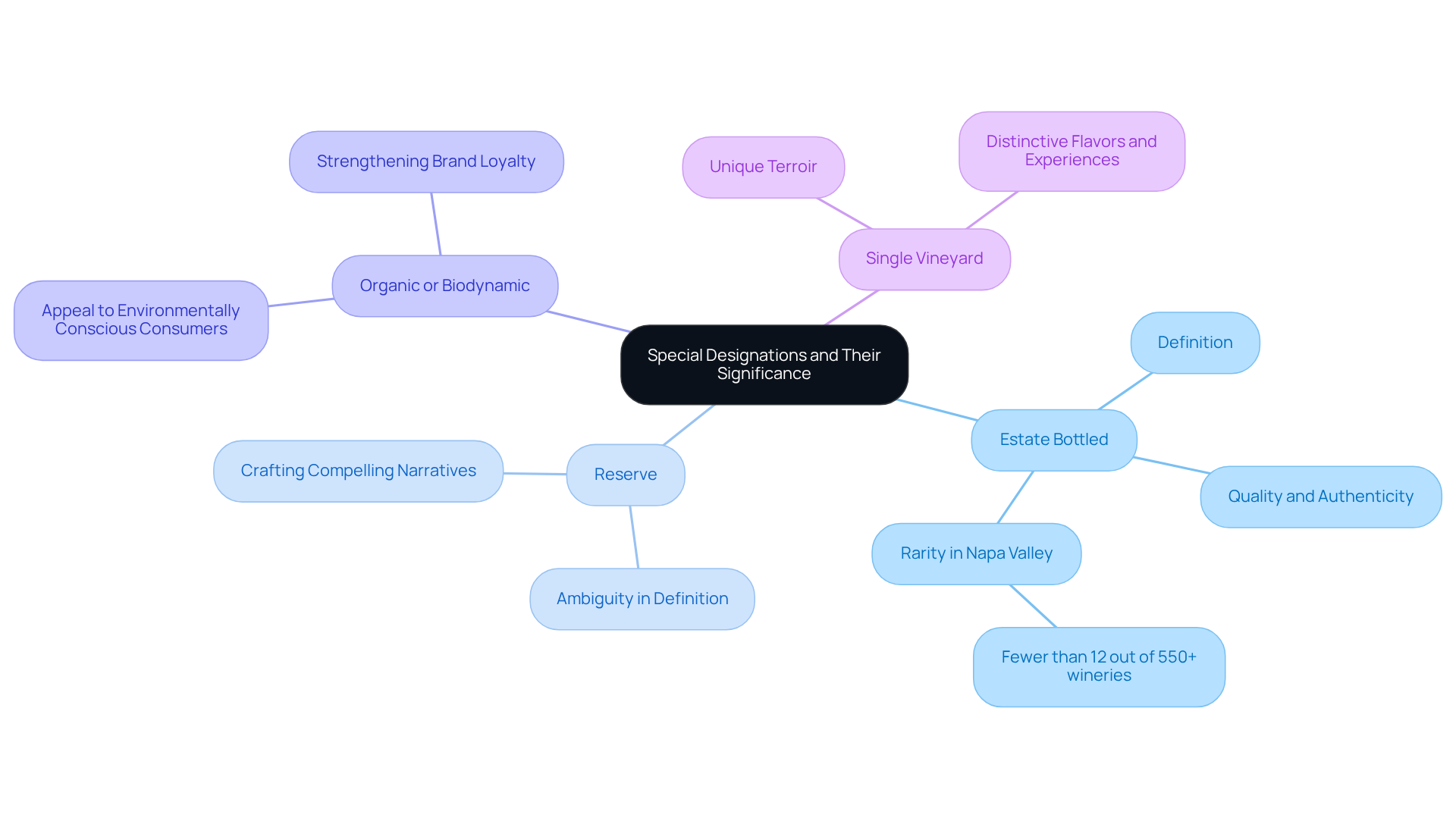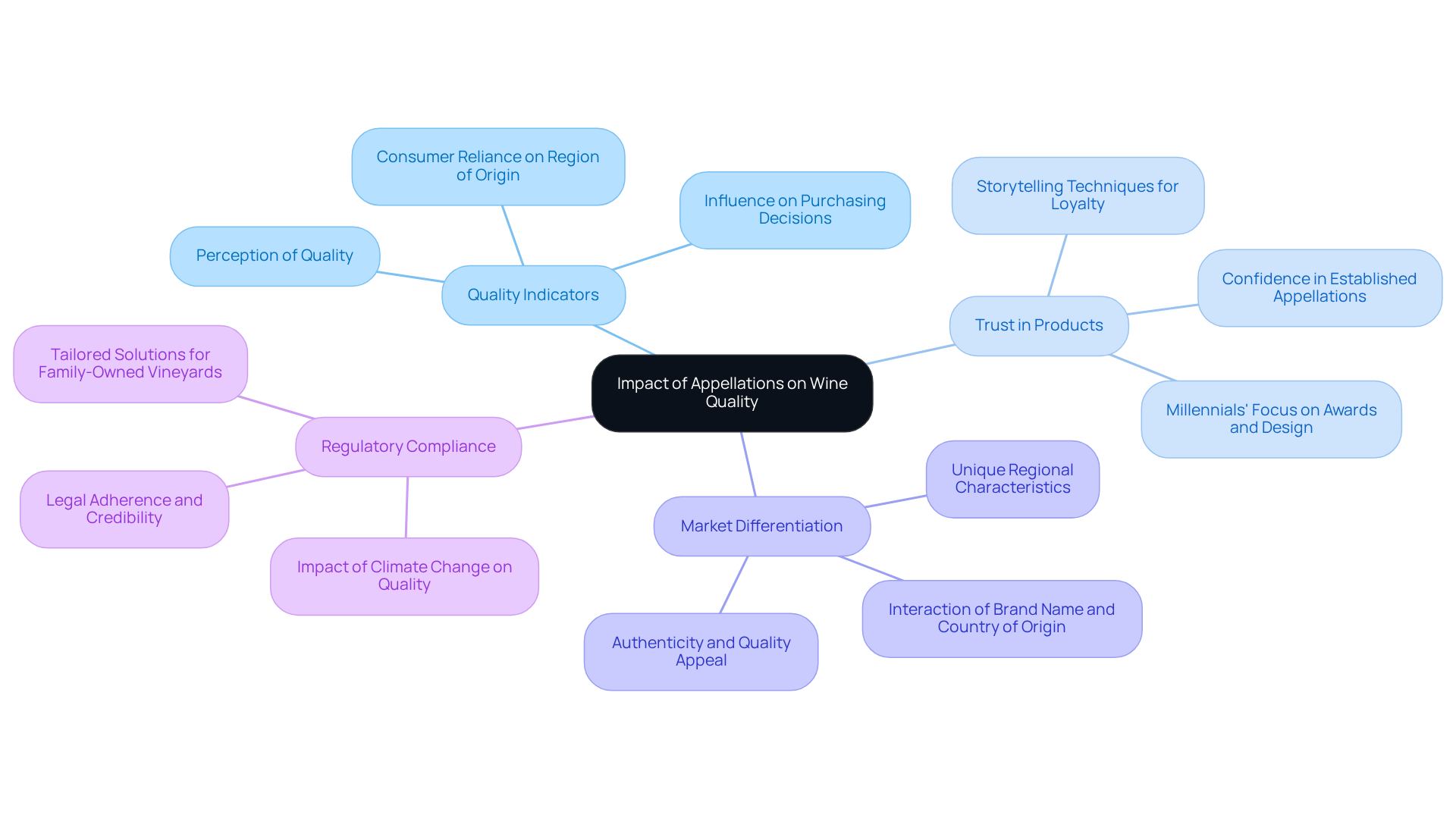Overview
The article emphasizes the critical steps for effectively marketing California wine labels, underscoring essential components, legal requirements, special designations, and the significance of appellations. Understanding and strategically highlighting these elements can significantly enhance brand recognition, consumer trust, and sales.
Statistics reveal that packaging design plays a pivotal role in buyer decisions, while compliance with labeling regulations is crucial for maintaining credibility in the market. By prioritizing these aspects, wine marketers can position their brands for greater success.
Introduction
Crafting an effective marketing strategy for California wine labels transcends the mere creation of an aesthetically pleasing bottle; it necessitates a profound comprehension of the multifaceted elements that sway consumer behavior. As the wine market undergoes rapid evolution, producers must adeptly navigate not only the visual allure of their labels but also the legal stipulations and consumer preferences that dictate purchasing decisions.
How can wineries harness these factors to not only entice buyers but also cultivate enduring loyalty in a fiercely competitive arena? This article explores the essential steps for mastering California wine labels, unveiling strategies capable of transforming casual consumers into devoted aficionados.
Identify Key Components of California Wine Labels
To effectively market California wine labels, understanding the key components of wine labels is essential. These elements not only communicate vital information but also significantly impact buyer decisions, converting casual purchasers into loyal club members. The primary components include:
- Brand Name: Often the first element consumers notice, this is crucial for establishing recognition and trust. A compelling brand name can evoke emotions and create a lasting impression, as seen with renowned wineries like Château Margaux, known for its elegant branding. Employing a color palette that represents the beverage’s character or heritage resonates emotionally with buyers while boosting shelf attractiveness, which is a crucial element of [impactful brand storytelling](https://blog.enocap.com/4-best-practices-for-crafting-effective-wine-newsletters).
- Wine Type: Clearly indicating whether the beverage is red, white, rosé, or sparkling helps buyers quickly identify their preferences, guiding their purchasing choices.
- Appellation of Origin: This specifies where the grapes were grown, enhancing perceptions of quality. For instance, wines from Napa Valley are frequently linked to high quality, influencing buyer preferences and strengthening the establishment's brand story.
- Vintage: The year the grapes were harvested is significant for buyers who associate specific years with quality. Highlighting a vintage known for exceptional conditions can attract discerning buyers and strengthen the winery's narrative.
- Alcohol by Volume (ABV): This indicates the beverage's strength, influencing buyer preferences, particularly among those mindful of their alcohol intake.
- Texture and Materials: The selection of texture and materials for the packaging, such as embossing or specialty paper finishes, can enhance the perceived quality of the wine, encouraging individuals to interact with the product on a tactile level.
By strategically emphasizing these components, wineries can tailor their marketing strategies to resonate with their target audience and promote California wine labels for sustainable growth. For example, Sokol Blosser Winery's recent effort to incorporate nutritional details on packaging reflects an increasing buyer demand for transparency, especially among younger purchasers who value understanding the contents of their products. Similarly, Copain Wines' shift towards ingredient transparency underscores the industry's direction towards more informative labeling. Furthermore, research indicates that 82% of buyers depend primarily on packaging to select their preferred beverage, highlighting the significance of efficient packaging design in boosting sales. Ultimately, a well-crafted tag not only informs but also , fostering a deeper connection with consumers while ensuring compliance with labeling regulations to maintain trust and support sustainable growth for family-owned wineries.

Understand Legal Requirements for Wine Labeling
Wineries must adeptly navigate a complex landscape of when labeling their products. Understanding these regulations is not just beneficial; it is essential for maintaining compliance and fostering consumer trust. Key regulations include:
- Appellation Requirements: To label a wine as 'California,' it is imperative that 100% of the grapes originate from California. For beverages designated with an American Viticultural Area (AVA), at least 85% of the grapes must be sourced from that specific region, ensuring authenticity and quality.
- Health Warnings: Labels must display government-mandated health alerts concerning alcohol consumption, aimed at educating individuals about the potential risks associated with drinking.
- Net Contents: The volume of wine contained in the bottle must be clearly stated, providing transparency to consumers regarding their purchase.
- Producer Information: It is mandatory to include the name and address of the bottler or producer on the packaging, which helps establish accountability and traceability.
Adhering to these regulations is crucial for wine producers to avoid legal issues and ensure that their California wine labels meet both state and federal criteria. Statistics reveal that many wineries face challenges in complying with these labeling regulations, with a significant portion of compliance problems stemming from misrepresentation or insufficient details on packaging. Successful strategies for compliance encompass thorough training for staff on labeling laws, regular audits of label designs, and leveraging technology to streamline the labeling process. As Alex Koral, Senior Regulatory General Counsel, aptly observes, "The devil, as always, is in the details, and as buyers and regulators demand increasing information about the content and origin of a beverage, producers need to stay informed about both the established regulations and upcoming changes." By understanding and implementing these requirements, wine producers can enhance their market presence while fostering consumer trust. Moreover, beginning July 1, 2025, all beverages sold in California must include a California Redemption Value (CRV) statement, making it essential for producers to prepare for this forthcoming requirement. By taking proactive measures, wine producers can ensure compliance and build a robust foundation for their branding efforts.

Explore Special Designations and Their Significance
Special designations on labels wield considerable influence over buyer perception and sales, acting as potent instruments in a vineyard's strategic capital planning and storytelling efforts. Consider the following common designations:
- Estate Bottled: This designation indicates that the wine was produced from grapes grown on the estate, suggesting a higher quality and authenticity that can enhance brand loyalty and consumer trust. Notably, fewer than 12 out of over 550 establishments in Napa Valley can claim , underscoring its premium nature.
- Reserve: While often implying superior quality, this term lacks a standardized legal definition. Establishments can leverage this ambiguity to craft compelling narratives around their Reserve offerings, emphasizing unique characteristics and exceptional craftsmanship.
- Organic or Biodynamic: These labels appeal to environmentally conscious consumers and can strengthen brand loyalty, aligning with the growing trend towards sustainable practices in the wine industry.
- Single Vineyard: This designation indicates a unique terroir, attracting consumers in search of distinctive flavors and experiences, thereby reinforcing the establishment's narrative and connection to its land.
By effectively utilizing these designations within a compelling narrative, producers can resonate with their target audience and unlock growth opportunities. Enocap's strategic capital planning services can assist family-owned vineyards in harnessing these designations to foster measurable growth, as evidenced by our clients' success in boosting e-commerce sales and digital club signups.

Recognize Appellations and Their Impact on Wine Quality
Appellations play a pivotal role in the marketing of California wines, fulfilling several strategic functions:
- Quality Indicators: Appellations are widely regarded as indicators of quality, with regions such as Napa Valley esteemed for their premium wine production. This perception can significantly influence purchasing decisions among consumers. Research indicates that daily wine drinkers in the U.S. place greater reliance on region of origin information compared to moderate drinkers, underscoring the importance of appellations as quality markers. Enocap's strategies enable wineries to capitalize on this perception, enhancing their direct-to-consumer revenue.
- Trust in Products: Wines that bear instill confidence in buyers, which can lead to increased sales. Notably, while brand recognition is important to both Millennials and older consumers, Millennials tend to prioritize fewer geographical cues, focusing instead on awards, label design, and alcohol content. This shift in purchasing behavior highlights the need for wineries to adapt their marketing strategies. Enocap's storytelling techniques can convert casual buyers into loyal club members by showcasing the unique narratives associated with each appellation.
- Market Differentiation: Wineries can effectively utilize their appellation status to distinguish themselves in a competitive landscape. By highlighting their unique regional characteristics, California wine labels can attract discerning buyers who are seeking authenticity and quality. The significant interaction between brand name and country-of-origin on price expectations further illustrates how appellations can shape consumer perceptions and trust. Enocap's innovative DTC strategies can assist vineyards in crafting compelling brand narratives that resonate with their target audience.
- Regulatory Compliance: Compliance with the regulations governing appellations not only ensures legal adherence but also bolsters a winery's credibility. This commitment to standards can further enhance customer trust and brand reputation. Additionally, considering the potential impact of climate change on wine quality is essential, as it may affect public perceptions of appellations in the future. Enocap's strategic capital planning provides family-owned vineyards with tailored solutions to navigate these challenges effectively.
By comprehending and leveraging the influence of appellations, wine producers can formulate targeted marketing strategies that highlight their distinctive attributes on California wine labels, ultimately appealing to a more discerning consumer base. As industry experts assert, engaging with these evolving dynamics enables wineries to remain relevant and informed, ensuring they deliver the most current and compelling recommendations to their clientele.

Conclusion
Mastering the art of California wine label marketing is essential for wineries aiming to thrive in a competitive landscape. Understanding and effectively utilizing key components such as:
- Brand name
- Wine type
- Appellation of origin
- Vintage
- Packaging materials
allows wineries to create labels that inform and tell compelling stories. This strategic approach enhances consumer engagement and fosters brand loyalty, ultimately driving sales growth.
The significance of:
- Legal compliance
- Special designations
- The impact of appellations on consumer perception
has been thoroughly examined. Wineries must navigate complex regulations to maintain credibility and trust while leveraging designations like "Estate Bottled" and "Organic" to appeal to discerning consumers. Recognizing the role of appellations as quality indicators can significantly influence purchasing decisions and market differentiation.
In conclusion, the journey to effective California wine label marketing hinges on a blend of creativity, compliance, and strategic storytelling. Wineries are encouraged to embrace these insights and adapt their marketing strategies to resonate with today's consumers. By doing so, they can enhance their market presence and contribute to the sustainable growth of the industry, ensuring that California wines continue to captivate palates around the world.
Frequently Asked Questions
What are the key components of California wine labels?
The key components of California wine labels include the brand name, wine type, appellation of origin, vintage, alcohol by volume (ABV), and texture and materials of the packaging.
Why is the brand name important on a wine label?
The brand name is crucial for establishing recognition and trust. A compelling brand name can evoke emotions and create a lasting impression, influencing buyer decisions.
How does the wine type affect buyer choices?
Clearly indicating whether the beverage is red, white, rosé, or sparkling helps buyers quickly identify their preferences, guiding their purchasing choices.
What is the significance of the appellation of origin on a wine label?
The appellation of origin specifies where the grapes were grown and can enhance perceptions of quality, with certain regions like Napa Valley often associated with high-quality wines.
Why is the vintage important to buyers?
The vintage, or the year the grapes were harvested, is significant because buyers often associate specific years with quality. Highlighting a vintage known for exceptional conditions can attract discerning buyers.
What does the alcohol by volume (ABV) indicate on a wine label?
The ABV indicates the beverage's strength, which can influence buyer preferences, especially among those mindful of their alcohol intake.
How do texture and materials of packaging impact wine perception?
The selection of texture and materials, such as embossing or specialty paper finishes, can enhance the perceived quality of the wine and encourage consumers to interact with the product.
How are wineries adapting their labels to meet buyer demands?
Wineries are incorporating nutritional details and ingredient transparency on their packaging to meet the increasing demand for transparency, especially among younger buyers.
What role does packaging design play in consumer behavior?
Research indicates that 82% of buyers primarily depend on packaging to select their preferred beverage, highlighting the importance of effective packaging design in boosting sales.
How can a well-crafted wine label benefit wineries?
A well-crafted label not only informs but also tells a story, fostering a deeper connection with consumers, ensuring compliance with labeling regulations, and supporting sustainable growth for family-owned wineries.




